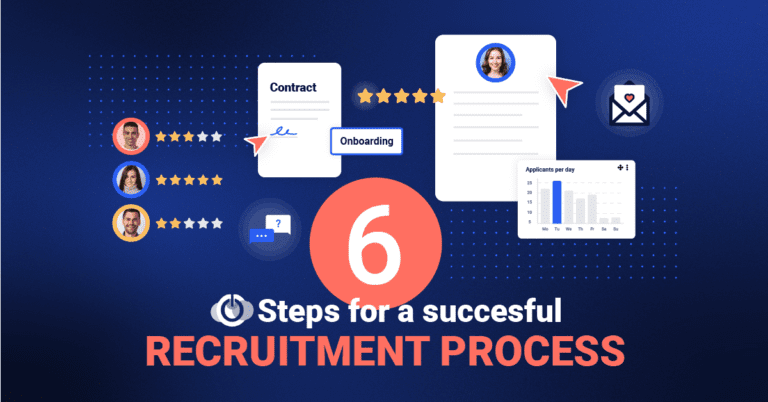6 Steps for a Successful Recruitment Process
All recruitment processes hold several steps that you, as a recruiter, must manage to ensure successful recruitment. This blog post will guide you through each step to ensure you have all the tools you need for your upcoming recruitment. The best part? You can make this process your blueprint for future recruitment processes.
When it comes to recruiting your new employee, you probably already have a more or less fixed procedure that you stick to when you are searching for the right talent. Fine-tuning the steps of this procedure can improve your chances of successful recruitment and save you both time and money in the long run.
This process is called the “Recruitment Life Cycle,” which can be used to employ any new employee for any position or department. From the part-time employee to the manager, following the steps of the Recruitment Life Cycle will increase the likelihood of finding the perfect new employee for your team. Once the Recruitment Life Cycle has been completed, all you have to do is save it for the next time you are looking for a new candidate.
To help you get started, we have outlined the following steps that you can learn more about below:
- Prepare
- Search
- Screen
- Select
- Hire
- Onboard
Prepare: Who Is the Perfect Candidate?
Preparing is the first step of conducting the initial research to get a good picture of the perfect candidate. Along with the rest of the hiring committee, you outline the competencies, educational background, and experience the upcoming colleague should possess.
The hard skills, the professional baggage the employee must have, are essential but don’t forget the soft skills! Soft skills are also necessary as they can help you assess whether this new employee will fit your company culture well. Once your focal points are locked, you are ready to compose the job description.
Search: It’s Time to Find Your Candidates
This next step in the Recruitment Life Cycle is the phase where you search for relevant candidates. Make sure you search for suitable candidates wherever they may be present online or offline – for example, in trade-specific news magazines.
If you are an HR-ON customer with access to HR-ON Recruit, getting your job ad off the ground is simple. One simple click is all it takes to reach all the relevant job portals and social media sites, and boom – your ad is online.
You can even target specific potential candidates, such as passive and active job seekers. Passive job seekers refer to potential candidates currently holding jobs and aren’t actively looking up job ads. LinkedIn is beneficial when it comes to reaching these passive candidates. Learn more about that here.
Screen and Select
It’s time for the third step in the Recruitment Life Cycle: screening the candidates. Once you have received a reasonable amount of applications from potential candidates, it’s time to go through their resumes and cover letters one by one.
In HR-ON Recruit, you and the rest of the hiring committee can share your thoughts on each candidate and their potential. You can add internal notes that are visible to the committee only. It can be relevant if you have made a simple phone screening of a potential candidate or if you have other information that you want to share with committee members.
Once you have completed the first three steps of the Recruitment Life Cycle, you should have a good idea of the sort of candidate you are looking for and a strong pool of candidates ready to be interviewed. Invite them for their interview and greet them with a solid list of relevant questions that you need to assess the candidates and their qualifications.
You may want to obtain references from potential candidates in this concluding part of the process. These can give you a stronger sense of the candidate’s personality and abilities.
If you are an HR-ON Recruit customer, you can easily apply the feature Candidate Presentation for the whole recruitment process. The Candidate Presentation is a digitalized feature that replaces the old pdf-compendium, which means printing CVs and resumes is a time of the past. Additionally, the Candidate Presentation complies with the legal requirements of GDPR.
Congratulations – You Got the Job!
Once you have completed the (hopefully) successful interviews, the time has come to choose the candidate you want to make your new employee. Call up the person in question and offer them the job. Call a meeting where all parties can sit down to discuss the details: conditions of employment, salary, working hours, etc. This meeting will mark the initial step of the preboarding process.
Want to learn more about the preboarding process? Click here and help your new employee to get off to a great start.
Before you call up your new co-worker, think about the terms you are willing to discuss in case the candidate wants to negotiate the terms. It may be a sensitive aspect of the meeting, so the more you prepare, the smoother this process will be. Prepare yourself to negotiate an acceptable deal for you and the employee.
Onboarding – Worth Your While
Once the candidate has accepted the job, the preboarding starts. If there’s a considerable amount of time from the hiring date to the date your new employee sets foot in the office, it can be a good idea to keep in touch with your new co-worker. You can send out relevant information they should know before their first day, share your employee manual, and invite them to upcoming events.
If you are an HR-ON customer with access to our HR-system HR-ON Staff, you can easily set up a preboarding and onboarding process with the so-called Engagements. It also allows you to obtain information quickly from the candidate itself. This incoming data is saved directly into your HR system. Preboarding and onboarding don’t get much easier than this.
The onboarding process takes over from the preboarding process once the new employee sets foot in their new workplace. The onboarding process includes practical tasks such as setting up the new computer and account, access to the workplace, introduction to systems and the company, and introduction to their new coworkers.
Learn more about the keys to a good onboarding process in this post.
Plan Your Cycle, Adapt and Use It Over and Over
Creating your Recruitment Life Cycle is simple if you are an HR-ON customer with access to the HR-system HR-ON Staff. HR-ON Staff automates your steps before, during, and after recruitment. You can even connect the tool Processes, where you can add all the stages of your recruitment process and add all the employees that are an active part of the recruitment.
You can constantly adjust and change your recruitment process, give access to your colleagues to be part of it, etc.
Best of luck with your recruitment process!
Put your recruitment life cycle into a system and reuse the template again and again with the HR-ON Staff tools.
Book your free demo today and try it for yourself.
What Is a Recruitment Life Cycle?
A Recruitment Life Cycle is the steps the recruiting employee takes in a recruitment process. From the very beginning to the onboarding of the new employee.
What Are the Steps to a Successful Recruitment?
In a recruitment process, the typical steps are: Prepare, Search, Screen, Select, Hire, and Onboard.
What Are the Benefits of a Recruitment Life Cycle?
Once your recruitment process is locked down, you can use it for future recruitment processes.

